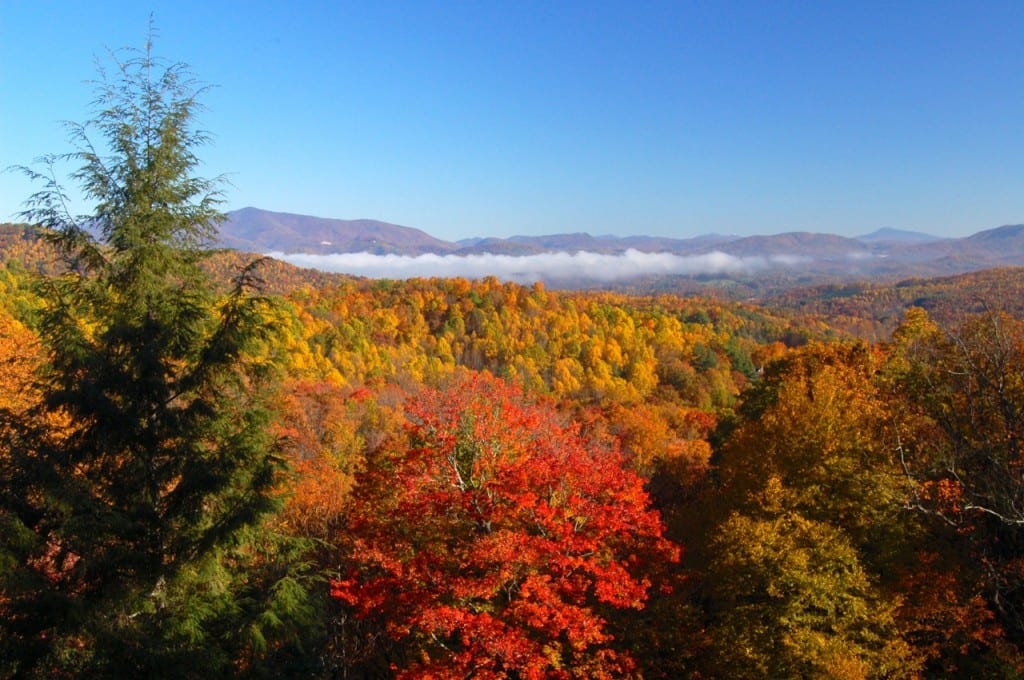By Glynn Wilson –
The autumn season is upon us, since the fall equinox occurred on September 22, and it is about to be a busy time of year for travelers who like to get outdoors and chase the changing leaf colors in the most beautiful of seasons in North America.
According to officials in the Great Smoky Mountains National Park, the most visited national park in the country, fall colors begin to develop above 4,000 feet in elevation in early October, while the peak colors come at lower elevations in spots such as Cades Cove and Townsend between the third week of October and the first week of November.
Weather factors determine the intensity of fall color season, including the amount of rainfall and night time temperatures.
“We’re staring to get the right conditions,” Park spokeswoman Dana Soehn said. “We generally shy away from predicting peak season and that’s due to so many variations in weather.”
But Wayne Clatterbuck, professor of forestry at the University of Tennessee, said while it is too early to predict the intensity of the fall colors, it is shaping up to be a good year.
“We’re in a dry period right now, and that’s usually pretty good,” he said. “We’ve had plenty of rain, but usually we want it to be dry and have some cool nights (in October). That tends to perpetuate the colors better. We don’t want it to get into the 30s, but the 50s or high 40s.”
Waning daylight as fall approaches is the signal for the trees to begin their autumn transformation, he told a reporter for The Daily Times in Blount County, Tennessee.
“The shorter day length helps trigger that leaf reaction. Generally, if it’s too wet or too warm, we don’t get as much vibrant leaf color. We’re looking for cool nights and dry weather,” he said. “We’ve got the dry weather now, it’s just predicting what the weather is doing in October.”
The biological mechanism for the change is a pigment called phytochrome, a photoreceptor that plants use to detect light.
“As the days get shorter, the trees know the growing season has ended, and that phytochrome will start triggering changes within the chlorophyll of the leaves,” Clatterbuck said.
During the past decades, perhaps due to climate change from global warming, leaf season has begun happening later in the year, at least a week-to-10 days later than it was 15 years go.
“We’re having warmer temperatures and that change is not occurring as rapidly as in the past,” Clatterbuck said.
According to the latest numbers from the National Park Service for 2012, of the 59 parks that fall under the jurisdiction of the park service, the top ten most popular are:
1. The Great Smoky Mountains National Park with 9,685,829 visitors.
2. Grand Canyon National Park with 4,421,352
3. Yosemite National Park with 3,853,404.
4. Yellowstone National Park with 3,447,729
5. Rocky Mountain National Park with 3,229,617
6. Zion National Park with 2,973,607
7. Olympic National Park with 2,824,908
8. Grand Teton National Park with 2,705,256
9. Acadia National Park with 2,431,052
10. Cuyahoga Valley National Park with 2,299,722
The list provides insights into the most popular destinations with travelers in the U.S. park system and indicate that travelers don’t seem to be growing tired of the parks. More than 282 million people visited a national park last year. That’s up from 2011 and the sixth highest total of all time, according to the National Park Service.
The autumn color season is also a busy time for state parks. While it is doubtful there will be much in the way of fall color yet, we will be camping out in the Lake Guntersville State Park on the first weekend in October, hoping for some early fall weather, cool nights and maybe just a hint of color to photograph.
A few photos from the archives from years past.



























